”With an income of $1,600 a month, I have to pay $1,625 in bills, so I need the food bank”
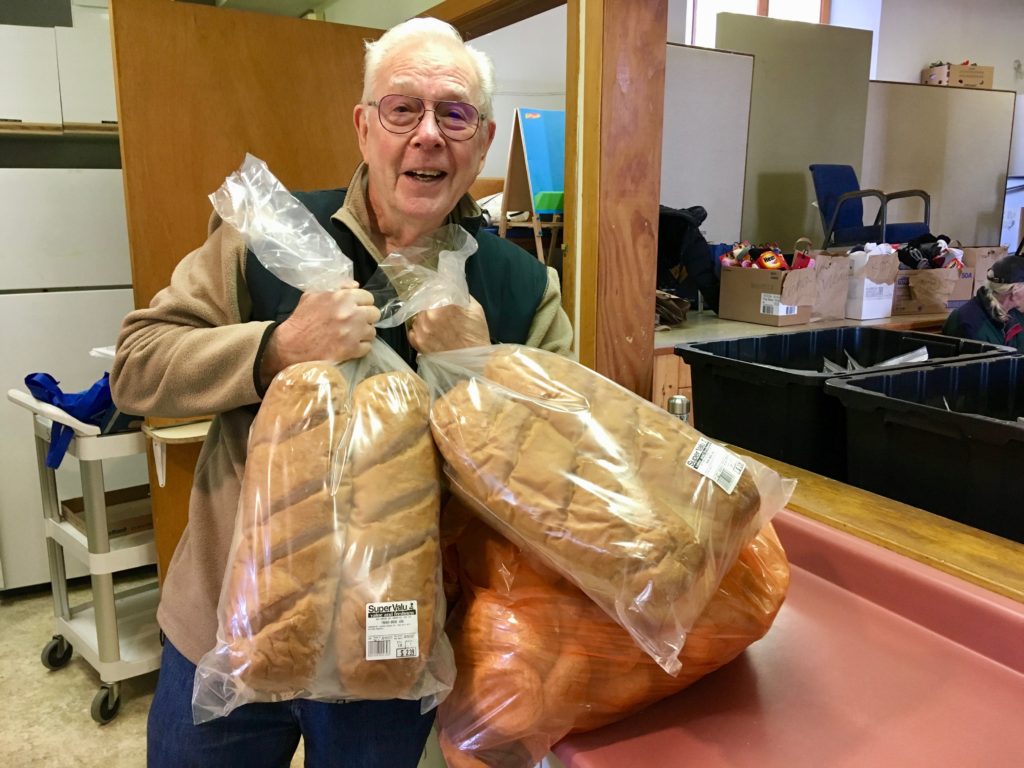
(By Margot Grant)
Although the doors of the food bank at St. Barts don’t open until 1 p.m., the first client shows up at 9:30. He walks into the church hall, grins, picks up a ticket with the number ”1” and happily surveys the tables.
It isn’t long before a second client arrives and carefully takes stock of the goods on the tables, deciding what to choose at one o’ clock. Each client gets to pick one or two items per table and early birds get the best picks.
One long table holds clothes and warm socks, personal hygiene items and home-cleaning supplies. The personal care items and some of the clothes are donated by London Drugs — items that did not sell within a certain time and would otherwise go to the landfill.
There is a table with leftover Christmas goodies, a long table with a variety of food items donated by London Drugs, and a table with bread and pies from IGA and SuperValu. A table with chocolate eggs nearing their ‘best before’ date sits next to a table with goods past that date but still perfectly good to eat.
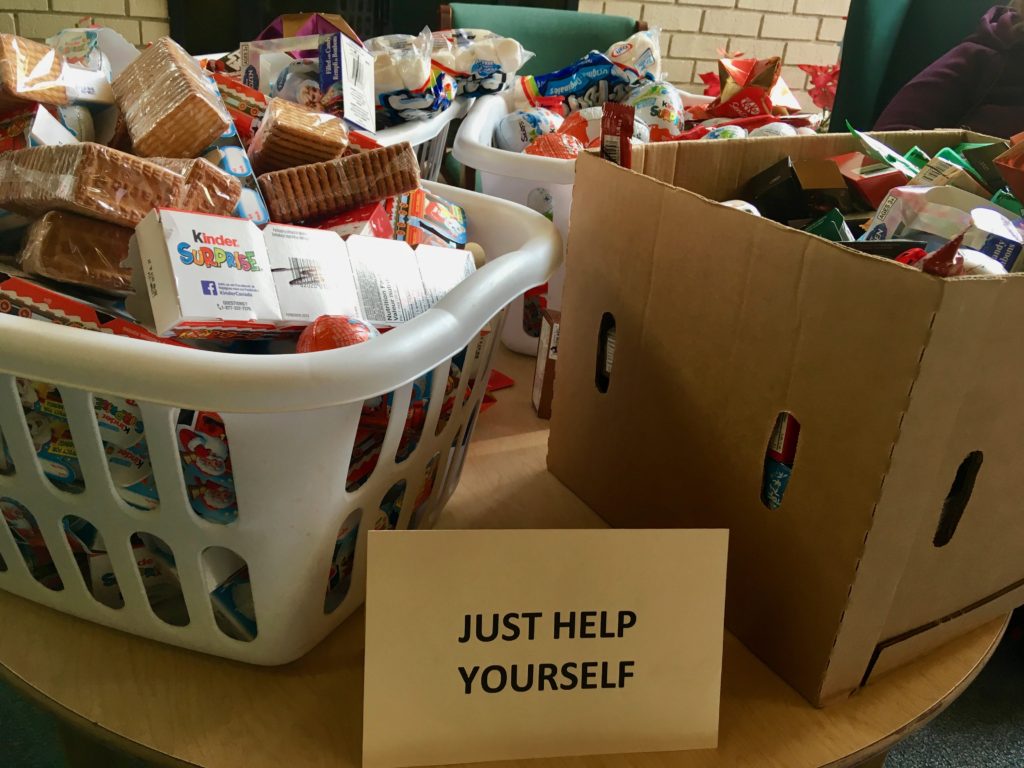
In the church kitchen, volunteers are busy filling plastic bags with flour, rice, oats, milk powder and pet food. After picking up an additional box of food in the basement, clients should have enough to eat for a week.
St. Bart’s food bank was created in 2010 to bridge the difficult week before welfare cheques arrive. The first week after the cheques, bills are paid and some food is bought. The Salvation Army food bank usually tides people over the next two weeks, but by the last week, kitchen cupboards can be bare. The food bank operates with about 20 volunteers.
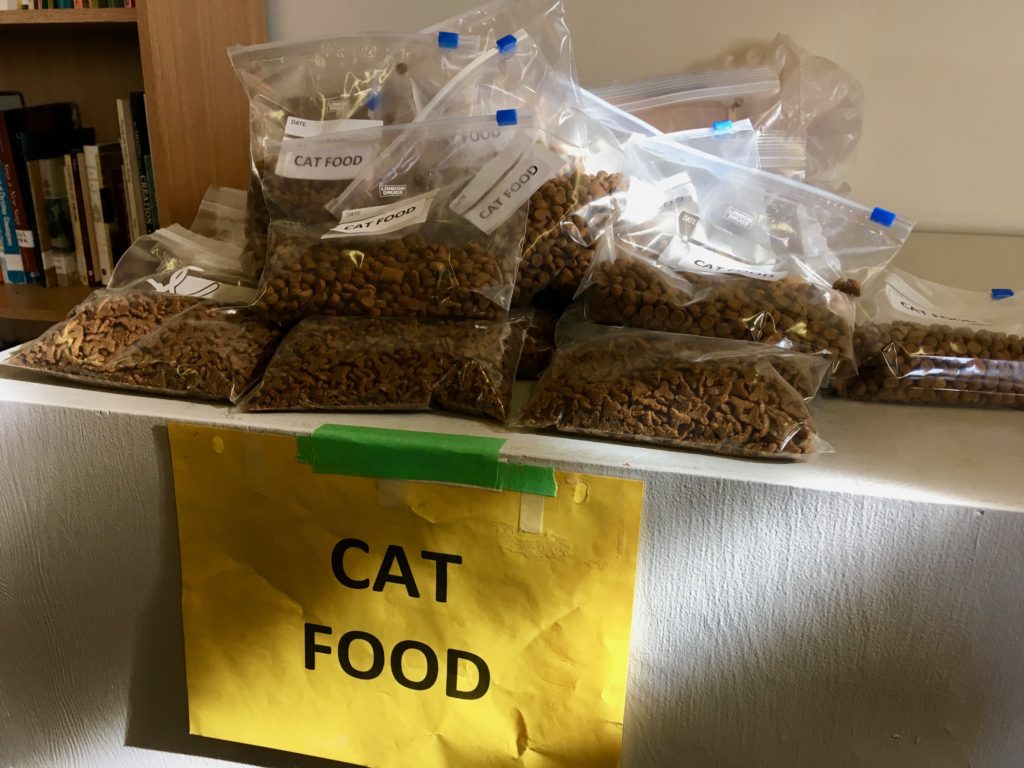
As the bench in the hall fills up, an older woman called Rachel arrives carrying two fur coats and several other items of clothing in good condition. ”They belonged to my late husband’s late wife,” she says. ”He died last month and I’m cleaning out the closets. I’ve been coming to the food bank for years, off and on, and I’d like to give back.”
With an income of $1,600, Rachel pays a monthly pad fee of $402 for her paid-off double wide, $200 for Hydro, $200 for Telus services, $92 for various insurance policies, $90 for ICBC, $490 in car payments for a 2017 Chevy Trax, $125 for natural gas, and $26 for property tax, for a total of $1,625.
”I don’t know yet how much I pay for water, I drive as little as possible to save gas and I’m very grateful the pad rent did not go up this year,” she says.
Why car payments of $490 for a fairly new car? ”My husband had serious health issues and I’m disabled. We bought the car when he was still alive and had a bit more money.”
She expects to get 60 per cent of his CPP — about $651 a month — and may not need the food bank in the future.
Not everyone uses the food bank all the time, church volunteer Vera Askew says. ”Some women come when their husband dies and they can’t find out how to get money. Other people are destitute, find a job, but come back when it ends. We saw a lot of people with the mill lay-offs a few years ago. Some women cry and say ‘I used to volunteer at the food bank and never thought I’d need it’.”
As she speaks, another woman walks in. ”What a beautiful fur coat!” she cries. It looks great on her, everyone agrees, and she happily leaves the hall with it. Coffee, Timbits, donated alcohol-free wine and flavoured water help to pass the time until one o’clock.
”For many clients, the food bank is also a social event,” says coordinator Susan Kimm-Jones. ”They meet friends and look out for one another. So-and-so has broken his arms, could we bring some food, or they’ll take a box for somebody who couldn’t come.”
In the church parking lot, a group of younger, warmly-dressed people are having a good time. Someone plays the guitar, dogs play, a toddler walks around, there is laughter. They live up in the mountains, says one of them, who identifies himself as Will.
He likes the idea of the food bank. ”There is an issue of supply in the world. Everyone on this planet should have food, shelter and clean drinking water. It is important to us that this food, which would otherwise go to the landfill, is used to feed people. Plus I’m on a near-zero budget right now.”
He spends most of his days sawing wood with a bow saw to keep warm and hauling water. ”I’d like to be totally self-sufficient and grow my own food, but the ground underneath the cedars is just not very good for that. I‘m thinking about bringing soil up from a clearing further down.”
It’s nearly one o’clock and a crowd has assembled at the doors. Men, women, seniors, young mothers with children, a man with a baby in a stroller, middle-aged people, people of various ethnicities, quite a few people in obvious ill health: the only thing in common is the need for food. The food bank clearly fills a need: in 2018, only the month of November was busier than this month.
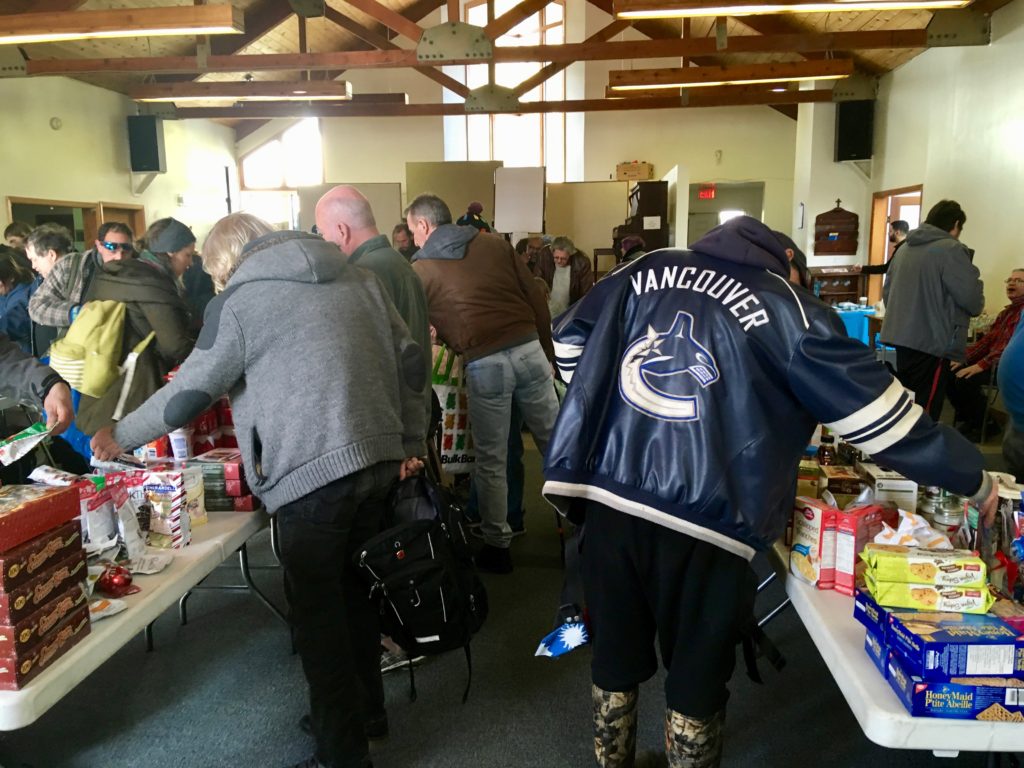
When the time comes, there’s a surge to a table with five volunteers. Newcomers are registered and quite a few do not have an address: they are couch-surfing, living in cars or cheap motels, sleeping rough or living permanently in the mountains.
Those already registered have their names checked and receive a slip of paper with the number of people they need food for. This Wednesday, St. Bart’s food bank will see 85 people and feed a total of 146.
About five years ago, a previous manager of London Drugs came to the hall and saw the food bank. He asked his head office if all items going to the landfill could go to the food bank instead, which was granted. When the project in Gibsons proved successful, London Drugs made it a company policy for all its locations.
Mark’s in Sunnycrest mall donated 24 pairs of warm socks for this Wednesday and sold the food bank an additional 125 pairs at 50-per-cent off.
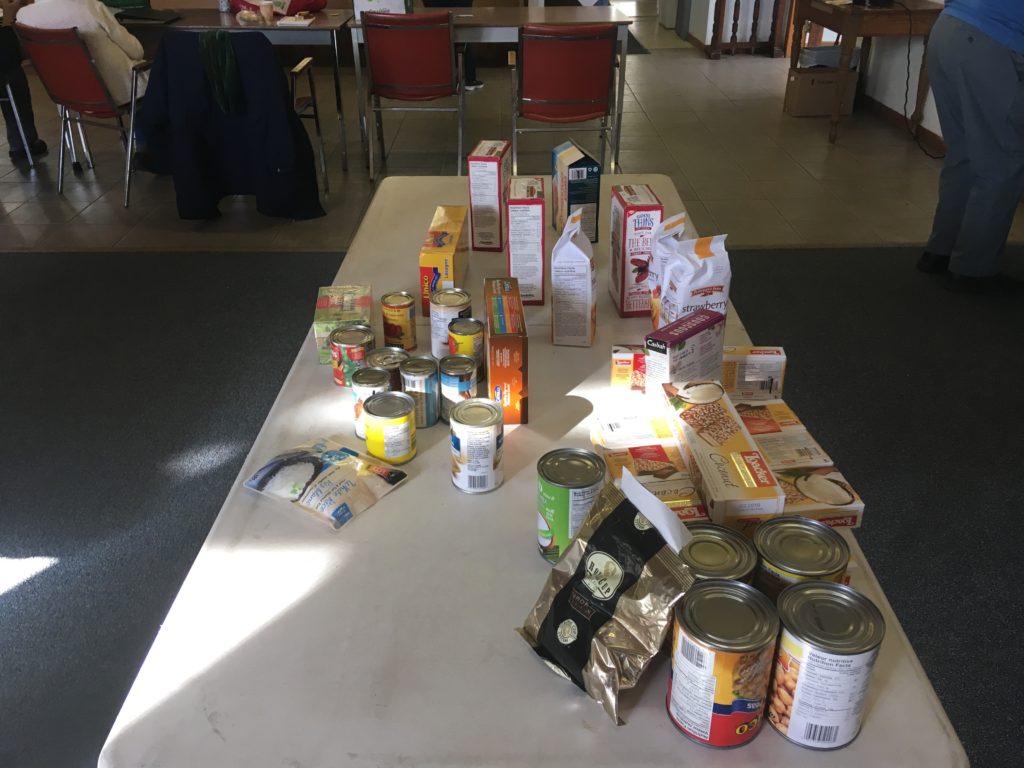
Within half-an-hour, the long table with food is almost empty and the socks and all but one or two personal-care items are gone. So are the cleaning supplies, two new pillows and a number of warm clothes; a lot of the bread has been taken and the enormous bowl of potatoes sits empty.
After people have made their choices in the hall, they go downstairs for the boxes. Depending on family size, these contain various amounts of cereal, peanut butter, crackers, pasta sauce, cans of soup, mac-and-cheese, bags of dry instant soup, small juice boxes, canned tuna, canned pork and beans, canned fruit, canned vegetables, dry pasta and toilet paper.
Each box is slightly different so people have a choice. They can exchange items for vegetarian or gluten-free ones if they want, and there is Ensure and Boost for those who need it. Thanks to the volunteers, the boxes are all packed and ready to go when the doors open.
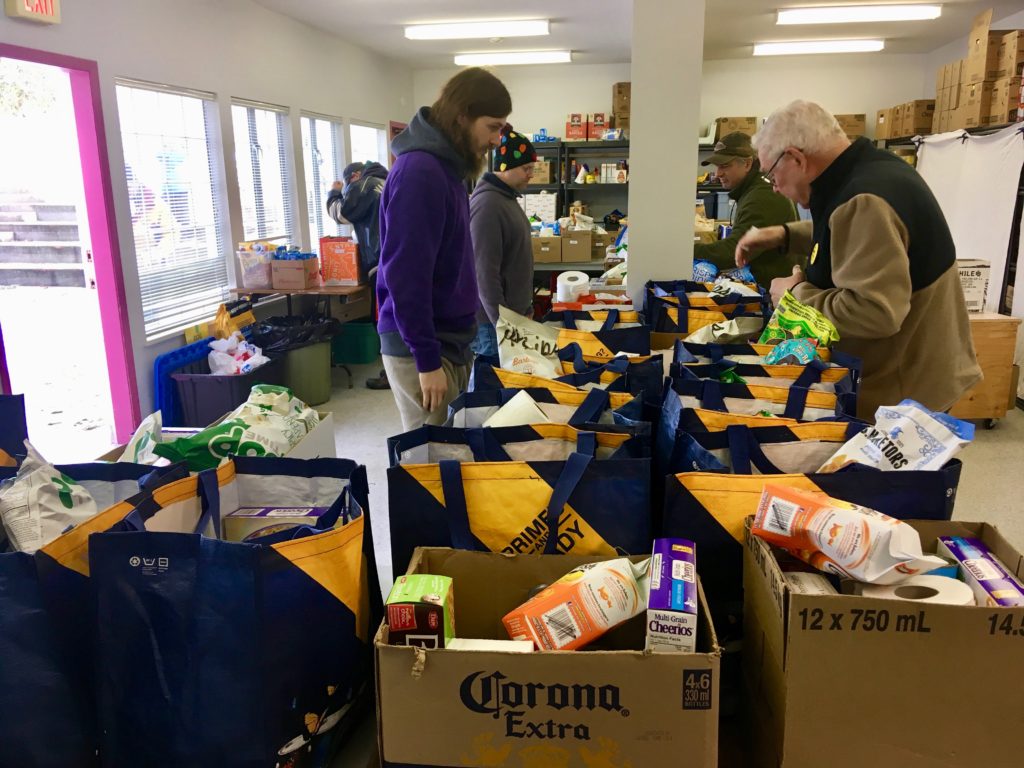
Shelves along the walls are lined with enormous amounts of food; another room holds even more. ”This community is unbelievably generous,” say co-coordinators Joan Lee and Susan Kimm-Jones.
The Thanksgiving food drive resulted in 400 bags of food, a drive by Elphinstone Secondary yielded 100 bags, Gibsons Building Supplies collected so much food in December that it needed to be delivered by crane, and the Gibsons Yacht Club, the Garden Club, the Town Preschool and Yoga by the Sea all donated generous amounts before Christmas.
Ordinary citizens bring cookies, food and money; a donation of $500 is not uncommon. The Landing Clothing Company raised $13,000 last year with fashion shows in the church hall. With the funds, the volunteers buy supplies not donated; they shop mostly local, and many businesses give discounts.
The Sunshine Coast TELUS Ambassadors do the weekly pick-ups at London Drugs, drive to Costco every month to pick up large items which can’t be bought on the Coast, and help out at the food bank.
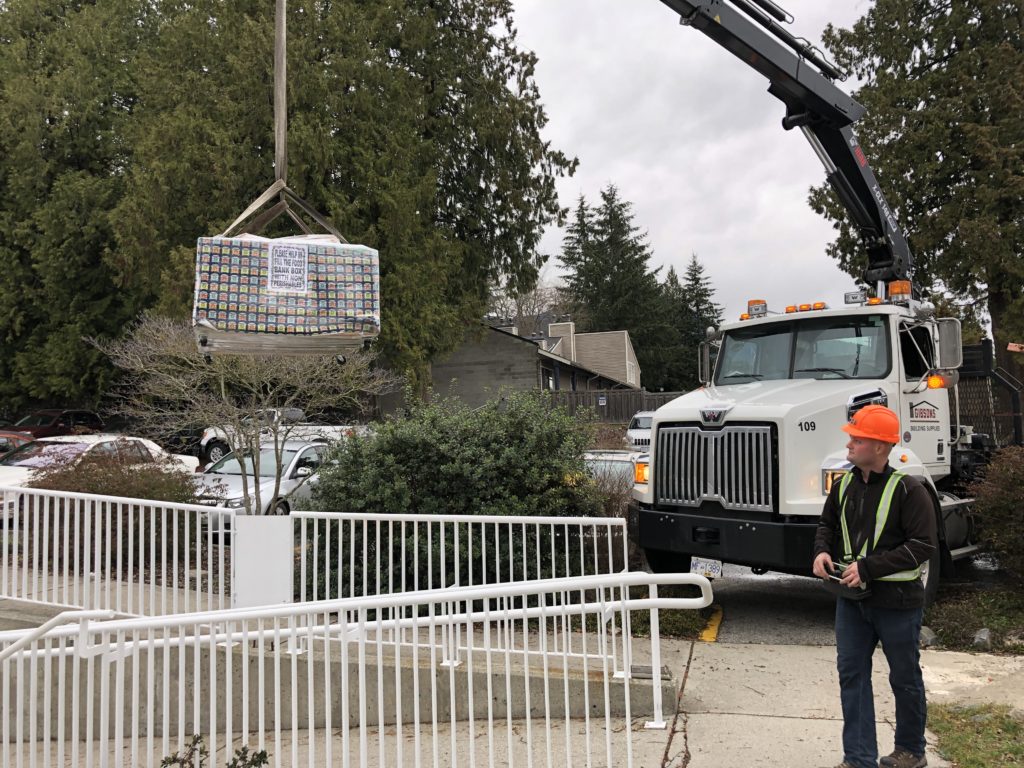
”I don’t know if I can ask this, but would you have some healthy snacks like granola bars for my kids when they come out of school?” a young mother asks politely. A volunteer cracks open a box and gives her some. Other volunteers are helping people to carry boxes to the parking lot.
A woman rushes in just before closing time. She looks exhausted. ”Two evictions today. All this stuff out on the street and no place for them to go. Can I bring them some food?” The volunteers know her and pack up some supplies. ”I’ll keep the croissants and the chocolates,” she says, with a wink.
Most people decline to talk about the circumstances that led to their use of the food bank. One woman, however, tells The Coast Clarion that she used to come to the food bank when she and her husband had a net income of $3,800 a month. They had a lot of medical costs, she says, and needed special diets.
”We don’t judge and we don’t check income,” Kimm-Jones says. ”People may be locked into contracts or have circumstances we are not aware of. There will always be a small percentage of people who take advantage. We don’t worry about it.”
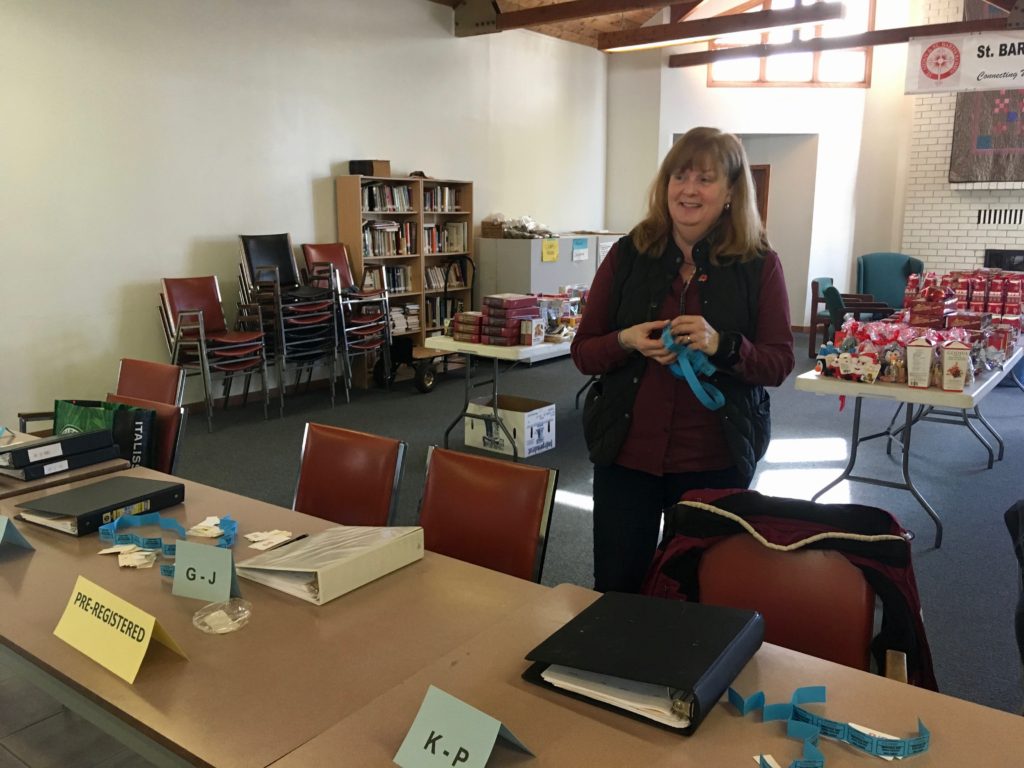
The food bank at St. Bart’s Church in Gibsons is open every third Wednesday of the month. It is located at the corner of North Road and Gibsons Way.
A great and detailed outline of the St. Barts program. I have long been confused by the various food banks on the Coast with some claiming they feed the whole Coast. A second article on who does what when it comes to Food Banks would help to fill that void.